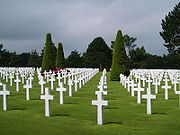Killed in action
Killed in action (KIA) is a casualty classification generally used by militaries to describe the deaths of their own forces at the hands of hostile forces.[1] The United States Department of Defense says that those declared KIA need not have fired their weapons but have been killed due to hostile attack. KIAs do not come from incidents such as accidental vehicle crashes and other "non-hostile" events or terrorism.[2][3] KIA can be applied both to front-line combat troops and to naval, air, and support troops.
Further, KIA denotes one to have been killed in action on the battlefield whereas died of wounds (or DOW) relates to someone who survived to reach a medical treatment facility. The North Atlantic Treaty Organization (NATO) also uses DWRIA, rather than DOW, for "died of wounds received in action." However, historically, militaries and historians have used the former acronym.
Societies honoring KIA
Many societies venerate those killed in action. They set aside days of remembrance for their militaries and combat dead, and they build memorials and cenotaphs in honor of their fallen. The families of those who die in combat, especially their next-of-kin, sometimes receive preferential treatment, such as military honors, exemption from taxes, and financial awards. National militaries also distinguish those killed in action with ceremonies and awards. They also build walls and memorials to honor those who died.
See also
- MIA – Missing in action
- WIA – Wounded in action
- POW – Prisoner of war
- Tomb of the Unknown Soldier
Notes
- ↑ "U.S. Department of Defense Dictionary: killed in action". http://www.dtic.mil/doctrine/jel/doddict/data/k/03003.html. Retrieved 2007-02-04.
- ↑ "The 'Lectric Law Library's Legal Lexicon On * Justifiable Homicide *". http://www.lectlaw.com/def/j059.htm. Retrieved 2007-02-04.
- ↑ "Nolo Press Legal Definition Homicide". http://www.nolo.com/definition.cfm/Term/51AB22D3-86AB-4B55-8648BC28B45909C0/alpha/H/. Retrieved 2007-02-04.
| This military-related article is a stub. You can help Wikipedia by expanding it. |

